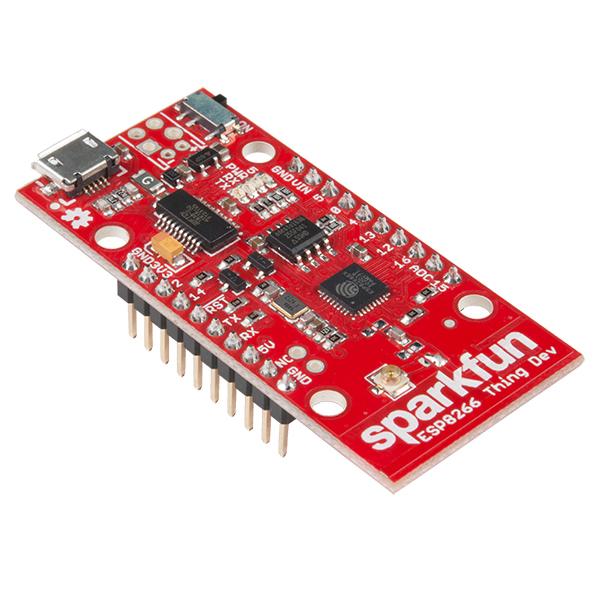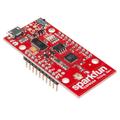SparkFun ESP8266 Thing - Dev Board (with Headers)

Description Attachments
The SparkFun ESP8266 Thing Dev Board is fondly referred to as the "Thing" because it provides the perfect base for your Internet of Things (IoT) project. It can perform a variety of tasks, from turning on an LED to posting data online, and can be programmed just like any other microcontroller. The Thing can be programmed through the Arduino IDE by installing the ESP8266 Arduino add-on.
The SparkFun ESP8266 Thing Dev Board is a relatively uncomplicated board. The pins are broken out into two parallel, breadboard-compatible rows. It also includes a USB connector, an optional power supply input, and an ON/OFF switch. The board features LEDs that indicate power, charge, and status of the IC. The ESP8266 operates at a maximum voltage of 3.6V, so the board includes a 3.3V regulator to deliver a safe, consistent voltage to the IC. This means that the ESP8266’s I/O pins also operate at 3.3V. If your project requires a power source other than USB, the board includes footprints for a 2-pin JST, 2-pin 3.5mm screw terminal, or a simple 2.54mm-pitch 2-pin header.
The Thing Dev Board comes with a PCB trace antenna as a default WiFi antenna. It is cost-effective and works exceptionally well. If a more sensitive antenna is required, or if you need to route outside an enclosure, a U.FL connector is also available on the board. Some soldering will be required to get the U.FL connector functioning.
The SparkFun ESP8266 Thing Dev Board comes with a range of features such as all module pins broken out, onboard FTDI USB-to-Serial, 802.11 b/g/n, WiFi Direct (P2P), soft-AP, integrated TCP/IP protocol stack, integrated TR switch, balun, LNA, power amplifier and matching network, integrated PLLs, regulators, DCXO and power management units, integrated low-power 32-bit CPU that could be used as an application processor, +19.5dBm output power in 802.11b mode, and pre-soldered headers.
Properties
| Brand | Sparkfun |
| Model | WRL-13804 |
| More info | ESP8266 Thing Development Board Hookup Guide - SparkFun Learn |
Customer questions
Customer Reviews
- In stock Sparkfun Copper Tape - Conductive Adhesive, 5mm - 15 meter € 7,75 View product
- In stock Sparkfun Teensy Stackable Header Kit (Extended) € 2,90 View product
- In stock Sparkfun Hobby Motor - Gear € 3,50 View product
- In stock Sparkfun Battery Holder 2xAA with Cover and Switch - JST Connector € 2,60 View product
- Sale In stock -72 % Sparkfun EasyDriver - Stepper Motor Driver € 21,25 € 6,05 View product
- In stock Sparkfun Thin Speaker - 4 Ohm, 2.5W, 28mm € 3,- View product
- In stock Sparkfun Alligator Clip with Pigtail (4 Pack) € 6,- View product
- In stock Sparkfun Toggle Switch € 3,30 View product
- In stock Sparkfun Clear Plastic Knob € 1,75 View product
- In stock Sparkfun Resistor 1K Ohm 1/4 Watt PTH - 20 pack (Thick Leads) € 2,15 View product
- In stock SparkFun Logic Level Converter - Bi-Directional € 5,15 View product
- In stock SparkFun Serial Basic Breakout - CH340G € 11,50 View product
- In stock SparkFun Audio Jack Breakout € 2,- View product
- In stock Sparkfun LED - Ultraviolet € 2,15 View product
- In stock Sparkfun Super Capacitor - 10F/2.5V € 6,25 View product










